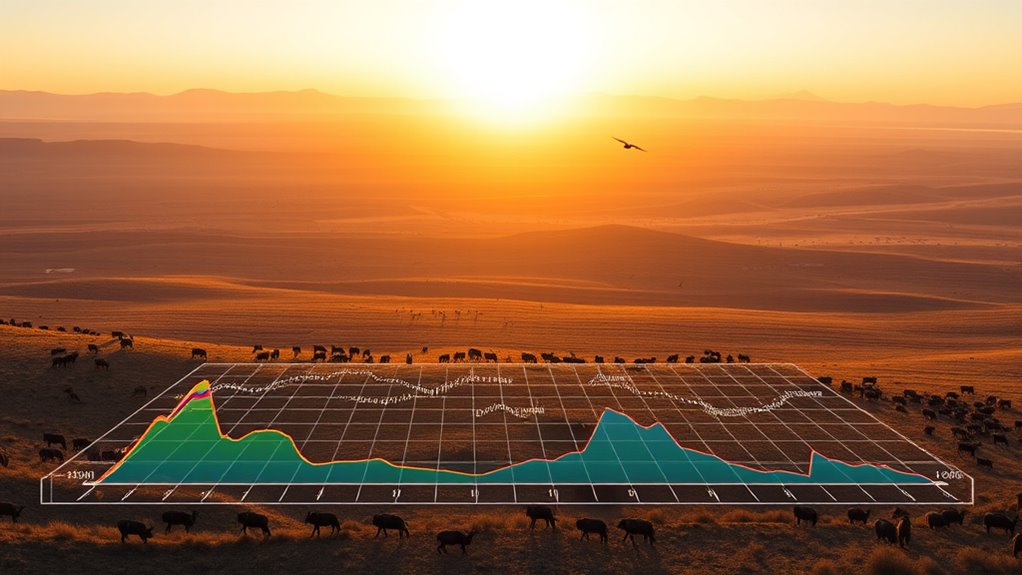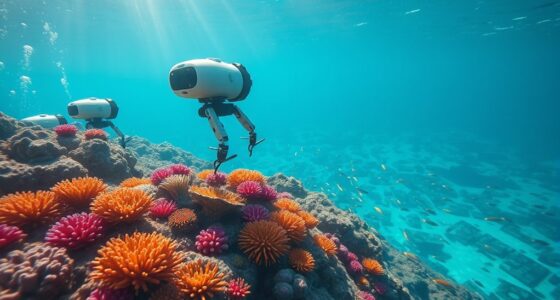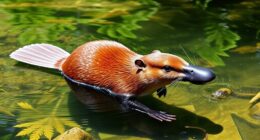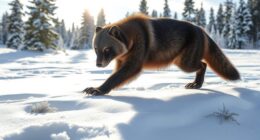AI models now analyze extensive wildlife migration data to forecast movement patterns with high accuracy. By considering factors like seasonal changes, food sources, and climate impacts, AI helps conservationists proactively protect species and critical habitats. This approach allows for better planning, resource allocation, and habitat management. As environmental conditions change rapidly, these predictions become essential. Stay with us to discover how these insights are reshaping conservation efforts and ensuring wildlife resilience.
Key Takeaways
- AI analyzes environmental and climate data to forecast changes in migration routes and timing.
- It identifies critical habitats and migratory corridors for targeted conservation efforts.
- AI models adapt quickly to climate-induced environmental shifts, enhancing prediction accuracy.
- Conservationists can allocate resources proactively based on AI-driven migration forecasts.
- AI supports policy development by providing data-backed insights into climate impacts on wildlife movement.
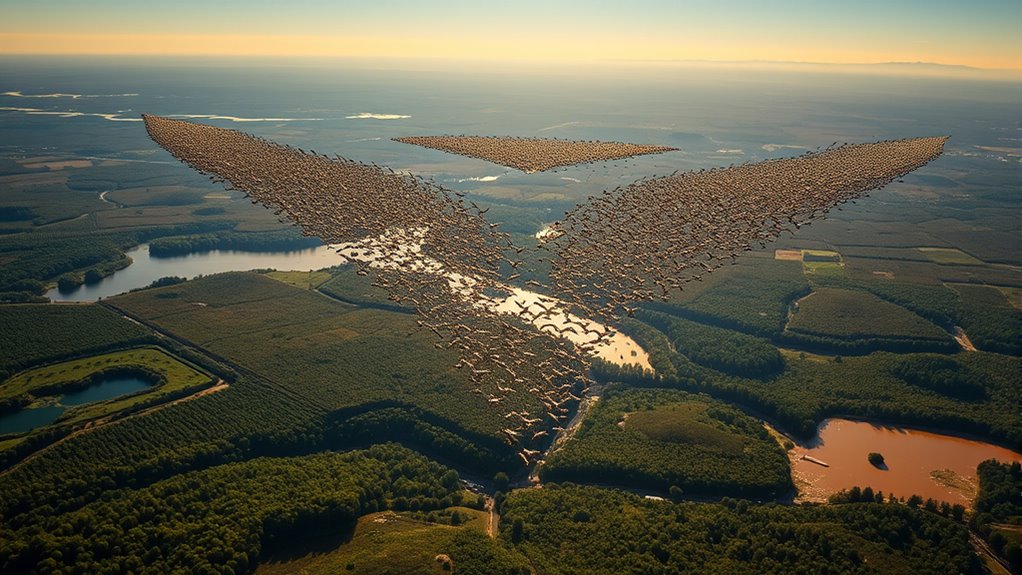
Advancements in artificial intelligence are revolutionizing how we comprehend wildlife migration. With AI, you can now analyze vast amounts of data to predict migration patterns more accurately than ever before. This technology considers numerous factors, including seasonal changes, food availability, and environmental cues, allowing you to understand how animals move across landscapes. One of the most significant benefits of AI is its ability to incorporate climate impact into these predictions. As climate change accelerates, traditional models often fall short in capturing rapid environmental shifts, but AI adapts quickly. It processes satellite imagery, weather data, and sensor inputs to forecast how migration routes might shift in response to rising temperatures, changing rainfall patterns, or habitat loss.
AI transforms wildlife migration predictions by analyzing environmental data and climate impacts for more accurate, adaptive conservation strategies.
By tracking migration patterns more precisely, you gain valuable insights into where animals are headed, when they’re likely to arrive, and how their routes might change over time. This knowledge is fundamental for conservation efforts because it helps you identify critical habitats that need protection or restoration. For instance, if AI models suggest that birds are altering their migratory routes due to climate impact, conservationists can prioritize these new corridors for preservation. It also helps in predicting potential human-wildlife conflicts, such as animals crossing roads or entering urban areas, enabling proactive measures to reduce accidents and habitat destruction.
Furthermore, AI’s ability to forecast migration patterns helps you optimize resource allocation. Instead of reacting to animal movements after they happen, you can prepare in advance—positioning wildlife corridors, adjusting land use plans, or deploying conservation resources where they’re needed most. This proactive approach minimizes disruptions and enhances the effectiveness of conservation strategies. Additionally, AI-driven predictions support policy-making by providing robust, data-backed insights into how climate impact influences migration. This empowers policymakers to implement adaptive management plans that are responsive to changing environmental conditions.
In essence, AI doesn’t just help you observe wildlife migration; it transforms your understanding of it. You can anticipate future changes, adapt your conservation efforts accordingly, and better protect vulnerable species. As climate impact continues to reshape ecosystems worldwide, leveraging AI for predicting migration patterns becomes an essential tool in ensuring the resilience of wildlife populations. It’s a powerful way to stay ahead of environmental changes, making your conservation work more targeted, effective, and sustainable.
Frequently Asked Questions
How Accurate Are AI Predictions Compared to Traditional Methods?
You might wonder how accurate AI predictions are compared to traditional methods. AI integrates ecological modeling and satellite imaging, which enhances precision in tracking migration patterns. Unlike traditional approaches that rely on manual observations, AI quickly processes vast data, leading to more reliable forecasts. While no method is perfect, AI’s ability to analyze complex data sets generally results in higher accuracy, helping conservationists make better-informed decisions for wildlife protection.
Can AI Predict Unexpected Changes in Migration Patterns?
Imagine tracking a flock of birds as they suddenly veer off course, their wings slicing through unpredictable air currents. AI can help you predict these unexpected changes by analyzing climate variability and predator influence, giving you a clearer picture of sudden shifts in migration patterns. While not perfect, AI’s real-time data processing allows you to anticipate surprises, helping you adapt conservation efforts swiftly amid nature’s ever-changing dance.
What Data Sources Does AI Use for Migration Forecasting?
You ask what data sources AI uses for migration forecasting. AI primarily analyzes satellite imagery to monitor real-time changes in habitats and migration routes. It also incorporates climate models to understand how weather patterns and temperature shifts influence animal movements. By combining these data sources, AI creates accurate predictions, helping conservationists anticipate migration changes and implement effective protection strategies.
How Do Conservationists Implement AI Predictions Effectively?
You can implement AI predictions effectively by integrating them into your conservation strategies, allowing you to anticipate migration patterns and address ecological impacts proactively. Use the insights to guide habitat preservation and minimize human-wildlife conflicts. Be aware of funding challenges, and seek partnerships or grants to support technology adoption. Regularly update your models with new data, ensuring your efforts remain accurate and impactful, ultimately enhancing wildlife protection efforts.
Are There Privacy Concerns With Wildlife Tracking Data?
In the age of digital dinosaurs, you might wonder about wildlife privacy and data security. Yes, there are concerns that tracking data could be misused or fall into the wrong hands, risking animal safety. Conservationists must prioritize secure data handling and anonymize sensitive information to protect wildlife privacy. By implementing robust security measures, you guarantee that valuable migration insights aid conservation without compromising the animals’ safety or privacy.
Conclusion
As AI continues to predict wildlife migration patterns, you realize how technology and nature unexpectedly align. It’s almost a coincidence—each new insight helping you better protect these species, guiding conservation efforts just when they’re needed most. With every prediction, you see the harmony between innovation and the natural world, reminding you that sometimes, it’s in these surprising moments that progress truly begins. Together, technology and nature can create a future where wildlife thrives.
